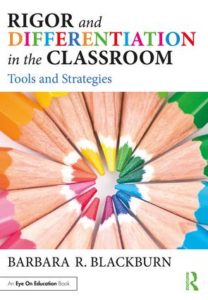Ensure Deep Learning as Virtual School Expands
 By Barbara R. Blackburn
By Barbara R. Blackburn
When you are teaching virtually, it’s easy to focus so much on the technology that we lessen emphasis on content. This is especially true when you are thrust into virtual learning with little to no preparation. We’re going to look at three strategies for ensuring rigor within virtual learning.
(If you follow my work, you know I don’t shy away from the word “rigor.” Please don’t assume I mean we should ignore SEL concerns or the stress many students are feeling in the midst of a pandemic. “Meaningful” is a key word here. So is “motivation.”)
Don’t sacrifice deeper learning.
Home and virtual learning should promote higher order thinking, not rote level tasks. There are times it is appropriate to do lower level tasks, but they should build to higher levels of thinking. In other words, look for technology that is more than a basic worksheet on the screen.
For individual work, project-based learning is a strong way to encourage students to learn at high levels. For 50 ideas for project-based learning visit this post at TeachThought. There are also a variety of other resources related to project-based learning.
Technology Resources
Novare PBL Platform is a project management tool which uses narratives, portfolios and learning goals to structure project-based learning. (Also see Getting Smarter’s 33 Quality Learning Platforms.)
Prezi incorporates video, audio, and other interactive research components for a presentation that keeps everyone’s attention. Free or low cost.
Project Foundry is a popular learning tool that enables students to plan their own learning and track their progress. It also makes organizing student projects much easier for students and teachers. Schools also love that Project Foundry gives students the chance to build digital portfolios – a necessary skill in today’s evolving technological culture. Some resources are available at no cost.
Scribble Press allows students options to share the work that they’ve done with others while reflecting on the experience as a whole. Scribble Press gives students the tools and support to write and illustrate their own books, as well as retell the story of their challenge-based experience, include final project results, and reflect on moments of personal growth.
If you have technology that allows for group experiences, one tool that can be effective is using simulations, which stage a recreation of an event, such as The Revolutionary War, so that students can experience it at a more in-depth level.
Additionally, math simulations are available at the Math Forum Library. By recreating an experience, students are more likely to make connections to themselves and real life, which leads to a higher level of analysis.
Scaffolding is more important than ever.
Finally, technology tools that provide support for students to process their learning in different ways also support rigor. In my social studies class, my students learned better by drawing a mind map or other graphic organizer, rather than listing information. Using apps and websites that allow students to create their own mind maps are helpful. Sample websites are available at eLearning Industry. Additional resources for mind mapping are available at Lifehack.
A second way to scaffold instruction is through the use of visuals. Whenever possible, provide students with a visual that supports learning, such as an image of a new vocabulary word or samples of products that you expect students to complete. You can easily find images on Google; simply search for the word, then choose images from the menu bar, noting copyrights. For work samples, you may be able to find an example online, such as a rubric for certain subjects, or you may need to create a sample.
A particular concern with older students is when they cannot read grade level text. Sometimes you must start with easier text in order to build to more complex text. One strategy for supporting students who are not reading at grade level is “layering meaning.”
If a student cannot read the grade-level or assigned text material, find another text on the same topic that is written at an easier level. Students read that selection first and build their own prior knowledge and vocabulary; then they can go back and read the more complex text with your support. It’s an excellent strategy, one that encourages rigor because students move beyond the easier text, but one that requires texts at differing levels. You can also use the strategy with more advanced students by choosing higher level texts. You can find sources for leveled text at BubbleUp Classroom.
Remember that your students are out of their routine, which affects their learning.
It’s important to remember that students are out of their regular routine, which can affect their learning. To ensure they can work at the highest levels, I’d recommend two strategies.
First, provide information to families about the importance of routines during at-home learning, as well as specific strategies for setting up routines. For example, families should ensure that students have a specific place for learning that includes needed resources. Families may need information about technology support. In my state (North Carolina), internet providers are providing free internet service as well as free installation to students. However, may families are not aware of this service.
Next, create routines in your lessons. Whether you are using paper-based lesson, or virtual lessons, use a template for the lessons and stick to it. For example, I use three steps: Think About It, which is a question to activate prior knowledge and/or set up the lesson; Learn About It, which is the content I present; and Apply It, which is where students produce something that applies their learning. This allows students to learn my expectations, and they come to expect the provided structure. By removing the uncertainty about a lack of routines, students can focus on rigorous learning.
A Final Note
Adjusting your instruction to home-based and virtual learning can be a challenge, and it’s tempting to create simpler lessons that are easy to complete. But educators need to ensure we hold students to standards that promote deeper learning, no matter the delivery system.



































